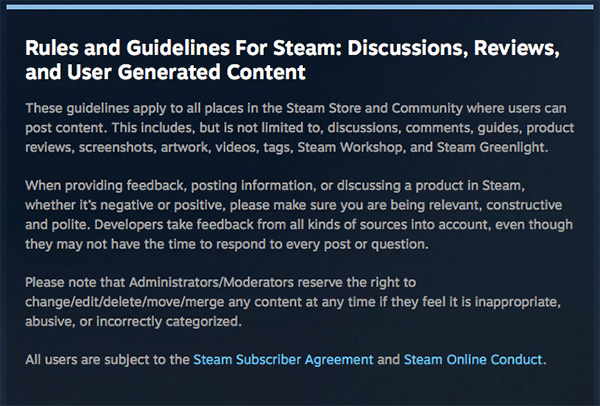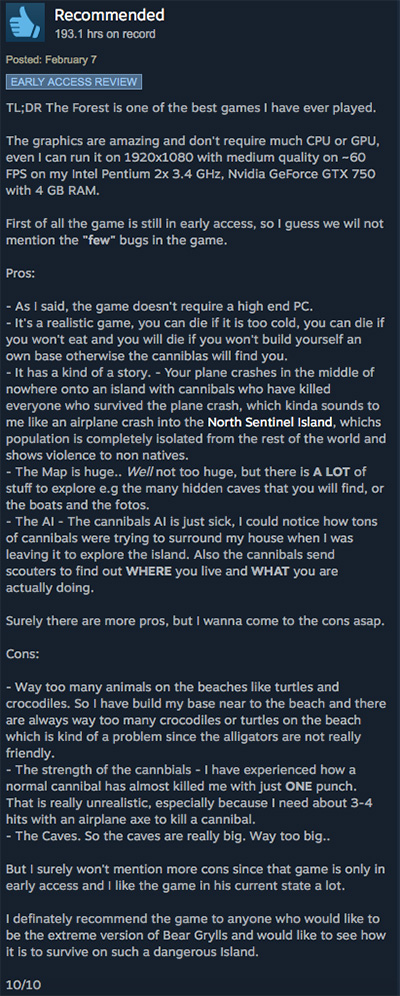Trending
Opinion: How will Project 2025 impact game developers?
The Heritage Foundation's manifesto for the possible next administration could do great harm to many, including large portions of the game development community.
Depending on which side you're on, Steam reviews can be your enemy, or your greatest ally. Today, I'm going to show you how to best utilize Steam reviews, no matter which side you're on.

This post originally appeared on IndieWolverine.com.
Steam reviews have come under much scrutiny lately and it's justified. Steam reviews in it's current state is far too open for virtually anyone to say anything about your game with minimal to zero repercussions. This leads to unhelpful, immature and sometimes appalling reviews. For the reviewer, there is nothing to lose. For the developer, there is everything to lose. Your reputation is on the line and with enough negative reviews, your long-term sales will certainly be impacted. Earlier this year, Emmy Jonassen wrote an excellent article titled, A Call for Responsible Steam Reviews in 2016. The article was a great call to action for Steam reviewers and definitely helped spread awareness of the sometimes unjust Steam review system.
With that being said, we can't just sit back and hope that all Steam reviewers will suddenly become mature human beings that are able to show empathy. The world would be a much better place if this were true, but sadly it's not. However, as a developer, there are many things that you can do to not only clean up your reviews (Steam allows you to flag any review that is abusive, off-topic or violates Steam guidelines & rules), but you can also learn from all of your reviews while earning more trust from your community and lastly, you just might sell some more copies of your game.
How might this be done, you might ask?
With just about any business, there are ways for customers to leave reviews. For restaurants, you have social sites like Facebook and review platforms like Yelp. For example, let's say you are in the mood for a nice fat juicy burger. After searching on Yelp for the best burger restaurants near you, you find a burger joint that has mostly good reviews. However, you notice that one of the most "useful" reviews is a one-star review from someone who had a bad experience with the restaurant. You might look past it and still give the restaurant a chance. However, if you are more of a picky eater, you might take a closer look at the negative review. If the negative review is not responded to and has many "useful" votes, you might move on to another restaurant and never look back.
However, what if you clicked on this negative review to find a personal and honest response from the owner who apologizes and goes over how the reviewer's issue has been resolved? You most likely will feel even better about the restaurant than you would have if the negative review didn't even exist. Not only are you more likely to eat at that restaurant, you are most likely going to have more respect for the restaurant and if your experience is good, you might even tell your friends and family about the restaurant.
The same goes for your video game. You're the chef, server, manager, owner and everything else combined. This is why we can't leave reviews unattended. When someone learns about your game, there is a very good chance that they are going to look at your reviews and if your score is low enough, you might fall in the dreaded "mixed" or worse overall Steam score. This immediately gives off a bad impression when someone visits your app page. Not only do they see a less than positive overall score, they are also met with an orange-ish negative association color. This happens before someone can even see more detailed information about your reviews.
Needless to say, for many independent games, this can absolutely cripple your potential sales at a moments notice.
This is where a routine review audit can help. During a Steam review audit, you will have the opportunity to respond to reviewers who have had a negative experience, you'll be able to flag reviews that are unhelpful to you and potential customers and you'll have the opportunity to greatly improve your game (sounds like a win-win to me).
The first thing I like to do when beginning a full Steam review audit, is create a spreadsheet (I use Google Spreadsheets). In this spreadsheet, I mark down the date, total reviews, total positive reviews and total negative reviews. In doing this, I can go back and see how the audit has affected various review metrics. A simple template can be found here: https://docs.google.com/spreadsheets/d/1l1ojSDpURGCRb5GDGa6doYx1opzNjhsuO6RQRZqi8Q4/edit?usp=sharing.

Before you log into your Steam account and start a flagging spree, make sure you understand Steam rules & guidelines.
Below is a quote from Steam on how to flag reviews:
"To flag a review:
Click the "Recommended" or "Not Recommended" headline of a review to open up the detail view of that review.
You will find a orange section in the right-hand column for "moderator controls" where you will see a drop-down for flagging the review.
Select "Abusive" if the review contains a scam, harassment, or is otherwise abusive to Steam users.
Select "Off-Topic" only if the review doesn't relate to your product or the service you are providing. An example is if the review talks about ice cream instead of your strategy game.
With either choice, you will get a confirmation dialogue. Then select "OK". Steam Community Moderators or Valve Employees will then review flagged reviews and delete or unflag as appropriate."
You can also respond to reviews. However, I urge you to respond very carefully as any misstep can take a small negative review and turn it into a huge discussion thread in your community and ultimately lead to a bad reputation among the Steam community. Below is another quote from Steam on how to respond to reviews:
"To reply directly to a review:
Click the "Recommended" or "Not Recommended" headline of a review to open up the detail view of that review.
You will find a orange section in the right-hand column for "moderator controls" where you will see a link for "Write Official Developer Response."
Once you click the link, you will be provided with a text field to enter your response. Please remember to keep it clear and concise. Similar recommendations apply here as in the Overview for moderating best practices above.
This response will then appear immediately below the related review and will be visible to anyone that can see the review."
To read more about Steam's review moderation guidelines, check out the official page here: https://partner.steamgames.com/documentation/moderating_best_practices#FlaggingReviews
In my experience, responding to reviews can lead to some excellent progress with your community. In some cases, I've had reviewers flip their negative reviews to positives because they simply had an issue and since resolved it, but forgot to change their review.
*Protip - Setup a support@ email and for anyone that expresses performance based issues, simply reach out and ask if their systems meet your game's minimum requirements. If they don't, then move on. If they do and are still having issues, try your best to help them. Also, if they don't know how to check if their system meets your minimum requirements, you can send them to this website: systemrequirementslab.com
While it might be tempting to zone in on all the negative reviews, there is equal value in the positive reviews. Positive reviews aren't always sunshines and rainbows, they can also include some excellent suggestions from your most dedicated players (without much incentive, it means a lot when someone goes out of their way to review your game and give it a positive score). In fact, many of your best player suggestions will come from positive reviews.

*Protip - Make sure you look at the dates for each review. While looking at some reviews, you might think to yourself "WTF, I fixed that a long time ago!!!", then you notice that you're looking at a review from 6 months ago. For these moments, it's best to reply to the reviewer and let them know that the issue has since been resolved (if they're nice, they might give your game another shot and even better, they might flip their review). I like to sort reviews by most recent and work my way down.
While looking through reviews, do your best to categorize any common issues. For example, if you notice reviewers complaining about the lack of graphics options or complaining that they can't find out out to change screen resolution, it might be a good idea to add more robust graphics settings to your task list. When documenting these common issues (you can make another Google Spreadsheet), try to list the common issue, how many reviewers have the same issue and best case scenario, list links to the reviewers with the common issues. in doing this, when you resolve the issues by certain reviewers, you'll be able to quickly go back to the review and respond, letting the reviewers know that their issue has been fixed. This shows that you are listening and taking action.
If you read a review that lists something that is easy for you to implement, don't respond to that review until you make the change. Reviewers don't care to hear about what you plan on doing, show them that you've actually taken action! This might not happen often, but when it does, you can look at it as low hanging fruit. This will give you the best opportunity to flip a negative review into a positive and it will also show potential customers that you are dedicated to your community.
The purpose of this audit isn't to just flag trolls and potentially get their unhelpful reviews removed. By having an actionable report at the end of your audit, you will be able to make your game better and build more trust with your community.
While this seems like a lot of work (and believe me, it is), it's incredibly helpful work. This is especially true for games that are in Steam Early Access. The good thing is that a full Steam review audit shouldn't be a monthly thing. For games with a smaller review count (a few hundred or less), you should be able to get by with a review 2 times a year or so. However, if you're releasing a major update, it might be good to monitor your reviews shortly after to see how players respond to your changes. Also, if you fix a bunch of issues at once, it would be a great idea to go back and respond to negative reviews that were based off of the issues you resolved (that's where the final review report really comes in handy).
For games that have a much larger audience, you might need to have someone (or a team of people) manage your reviews whenever you release a major update, or 3+ times a year.
However, everyone and everything is a beautiful snowflake in my eyes, so results may very. You might be able to get by with one audit a year (but that's totally up to you and your results).
That's it for this post! I hope everyone who reads this gets some good ideas and I hope more people take some time to better monitor their Steam reviews. Only together can we destroy this evil that is Steam reviews!
Read more about:
BlogsYou May Also Like